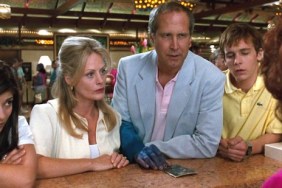
The children all gather at their parents’ home for the funeral. The family dynamic, though, stays the same, and the old family confrontations are never honestly revealed.
Why all this obsession with the family unit? It may be a clue to include the facts that Ozu never married himself, and lived with his mother until her death.
There are no “gimmies” in Tokyo Story. No musical indicators, no explosive monologues, no dramatic arguments or grand reveals to dictate how the audience is supposed to feel. We instead get the family dynamic from the family itself. We sit in square rooms with them, see their frustration, feel the frantic Sisyphean workaday struggle of modern city life. We feel the shame in not being able to relate to our own family, the frustration of closely guarded emotion, and the crushing inescapable prison of polite society. By the time the funeral occurs, we know all of the characters intimately, their complicated relationships, and we know exactly what needs to be said, and exactly why none of them can or will say it.
Ozu’s films make you feel like you are staying in as a guest in the house of someone you don’t know too well. You are okay with being sheltered, but you feel a little awkward about making yourself too comfortable. You observe your hosts, and may recognize awkwardness or animosity between them, but you are far too polite to bring such things to the fore.

Much of Tokyo Story depends on the tenets of polite Japanese society in the 1950s. Just like in post-war America, post-war Japan was a time of rebuilding, and of economic plenty. People moved to big cities and the job market was booming. The entire country was still smarting from major losses (although Japan’s losses were far more overwhelming than America’s), but doing a good job of ignoring the unpleasantness and getting boldly back on its feet.
America in the 1950s is notorious for its clean-cut all-white politeness. All non-conformity was frowned upon, and idyllic suburban life became popular culture’s heaven. This heaven was not allowed any violent emotions or cracks in the façade. Every comment had to be filtered through the popular idea of the polite family. This is an oversimplified version of the time I know (I was not alive in the 1950s), but it is what I have gleaned from my parents, and from films and literature from the time.

Japan had a similar fantasy of idyllic urban life. People working hard for the good of the country, treating people with quiet respect and dignity, and caring after their familial legacies with deft aplomb. I know it’s a stereotype to call Japanese people “quiet and polite,” but watching Tokyo Story, you see the crushing social importance of remaining quiet and polite, even to your family, even during funerals, even to strangers, even to everyone all the time.
So what do we do when important family details need to be discussed, or we need to reveal our deep emotions to the people closest to us? Well, it’s rude to put others in so awkward a position. In most melodramas, we get a cathartic moment where the characters are finally able to strip themselves of all bounds, and shout how they actually feel. In real life, though, and especially in polite society, those catharses never come. We often choose to leave our masks on for the sake of smoothness and continued relations.
There’s a lot we want to say, but there’s more we don’t say. Tokyo Story screams everything at us everything we don’t say.
Chishu Ryu’s performance is truly amazing, that he is able to express just how disappointed he is, just how depressed and torn he is, all while wearing a small quiet smile, and not saying anything out of turn.
The Craft

I’ve talked about Ozu’s technical craft, so let me tell you what it entails, in order to give you a better framework where to place this story.
The first thing one may notice about Ozu’s films is that the camera never moves. In Tokyo Story, I think there are only two tracking shots, no pans, and no zooms. All the rest are entirely static. We’re forced to look at the characters and the single room they sit in. We are not distracted by flourishes.
Ozu is famous for what is often called “tatami view” angles. That is, if the characters are sitting, he brings the camera’s point of view down a few feet, so we’re sitting at eye level with the actors, as if we’re sitting on a tatami mat in a typical Tokyo home. It’s a relaxing technique, and makes me feel more comfortable as the usual standing-angle cameras employed in most films. If characters sit in Western film, the camera will tilt or pan down with them. Ozu lets the camera sit down, and has the characters fill the frame.
Ozu frames all his shots very deliberately, almost like Kubrick. All the interior shots are carefully framed by windows, doorways, proscenia, sliding screens. All the shots are almost like stage compositions. Every teapot, every background banner (mostly hand painted by Ozu himself), every tatami mat and robe and widow is deliberately placed within the frame. He is showing typical Japanese urban life, but he is also composing meticulous photographs.
(A note on the banners: I am not fluent in Japanese, but I have studied it a minute amount – I did recently finish an 1100-page Japanese medieval epic – and I am familiar with the importance of calligraphy in Japan. A letter in the Japanese language has several meanings. A letter is a piece of visual art, a word, a pun, and a name all at once. The banners you see in Ozu films are never incidental.)








